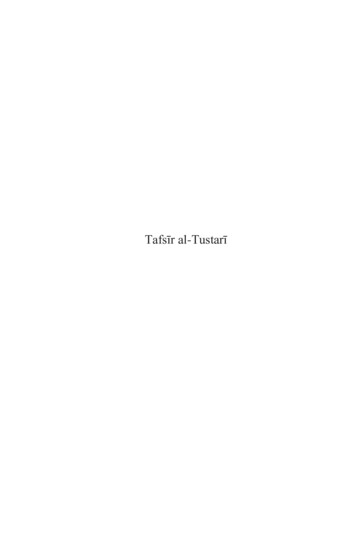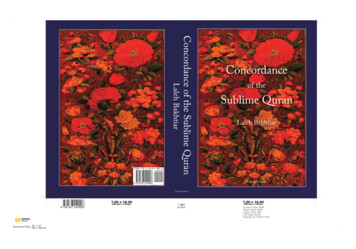
Transcription
Tafsīr al-Tustarī
Tafsīral-TustarībySahl b. ʿAbd Allāh al-TustarīGreat Commentarieson the Holy Qurʾāntranslated byAnnabel Keeler and Ali KeelerRoyal Aal al-BaytInstitute forIslamic ThoughtFONS VITAE
First published in 2011 byFons Vitae49 Mockingbird Valley DriveLouisville, KY 40207http://www.fonsvitae.comEmail: fonsvitaeky@aol.com 2011 Royal Aal al-Bayt Institute for Islamic ThoughtAmman, JordanGreat Commentaries on the Holy Qurʾān: ISSN: 1943-1821Library of Congress Control Number: 2011922358ISBN 9781891785191No part of this book may be reproducedin any form without prior permission ofthe publishers. All rights reserved.This book was typeset by Neville Blakemore, Jr. and Muhammad HozienPrinted in Canada
ContentsAcknowledgementsixPrefacexiIntroduction to the Translationxvi.Sahl al-Tustarī’s Spiritual Formation and his Teachersii. Tustarī as Spiritual Master, and his Disciplesiii. Tustarī’s Worksxvxixxxiiiiv. The Tafsīr al-Qurʾān al-ʿaẓīmxxvv. Tustarī’s Approach to Qurʾān Interpretationxxvivi. Mystical Teachingsxxxvii. ConclusionIntroduction to the Commentarylix11Al-Fātiḥa102Al-Baqara123Āl 7Al-Aʿrāf718Al-Anfāl819Al-Tawba8310 Yūnus11Hūd12 Yūsuf88919513 Al-Raʿd10014 Ibrāhīm10215104Al-Ḥijr16 Al-Naḥl10717 Al-Isrāʾ11218 Al-Kahf11519 Maryam11920 Ṭā Hā124v
Tafsīr āb15734 Sabaʾvi16035Al-Malāʾika (or Fāṭir)16136Yā Sīn16337Al-Ṣāffāt16538 Ṣād16739Al-Zumar17040Al-Muʾmin (or Ghāfir)17541Al-Sajda (or Fuṣṣilat)17742Al-Shūrā (or Ḥā Mīm ʿAyn Sīn 9Al-Ḥujurāt20050 l-Ḥadīd22058Al-Mujādila224
Contents59 Al-Ḥashr22660 Al-Mumtaḥana22961231Al-Ṣaff62 Al-Jumuʿa23363 Al-Munāfiqūn23464 Al-Taghābun23665 Al-Ṭalāq23766 Al-Taḥrīm23867 Al-Mulk24068 Al-Qalam (or Nūn)24269 Al-Ḥāqqa24470 Al-Maʿārij24771 Nūḥ25072 Al-Jinn25173 Al-Muzzammil25374 Al-Muddaththir25575 Al-Qiyāma25776 Al-Insān25977 Al-Mursalāt26178 Al-Nabaʾ26379 Al-Nāziʿāt26580 ʿAbasa26781 Al-Takwīr26882 Al-Infiṭār27083 Al-Muṭaffifīn27284 Al-Inshiqāq27485 Al-Burūj27686 Al-Ṭāriq27787 Al-Aʿlā27988 Al-Ghāshiya28089 Al-Fajr28290 Al-Balad28591 Al-Shams28892 Al-Layl28993 Al-Ḍuhā29194 Al-Inshirāḥ29395 Al-Tīn29596 Al-ʿAlaq296vii
Tafsīr al-Tustarī97 Al-Qadr29798 Al-Bayyina29899 Al-Zalzala299100 Al-ʿĀdiyāt301101 Al-Qāriʿa302102 Al-Takāthur303103 Al-ʿAṣr304104 Al-Humaza306105 Al-Fīl308106 Quraysh309107 Al-Māʿūn310108 Al-Kawthar312109 Al-Kāfirūn313110 Al-Naṣr314111112 Al-Ikhlāṣ317113 Al-Falaq318114 Al-Nās320Appendix of Names Cited323Bibliography333Index I: Qurʾānic Citations343Index II: People and Places353Index III: Subjects and Technical Terms359Plates follow page lx.viiiAl-Masad316
AcknowledgementsWe would like to express our sincere gratitude to HRH Prince Ghazi bin Muhammad who firstinvited us to embark on the translation of a Sufi tafsīr for the Great Commentaries on the QurʾānProject, and to the Royal Aal al-Bayt Institute, Amman, Jordan, for their generous patronage ofour translation of the Tafsīr al-Qurʾān al-ʿAẓīm of Sahl b. ʿAbd Allāh al-Tustarī. We would alsoparticularly like to thank the Series Editor, Yousef Meri, for his tireless support in overseeing thetranslation through all its different stages, for his careful perusal of the English translation againstthe Arabic original, and for his help and many suggestions regarding the referencing in the annotation of the translation.We would also like to offer our thanks and appreciation to Samir Mahmoud, here in Cambridge,who has gone through the whole translation, both at an early stage, and in its final draft. Being anative speaker of Arabic and having fluency in English as well as a proficient knowledge of Sufism,his comments and suggestions on many details of the text, and his answers to our many queries,have been invaluable. Also here in Cambridge, we would like to thank Aziza Spiker, who has actedas proof reader and copy editor for the translation, and who has also made pertinent commentsabout the translation of some of the Qurʾānic verses. Our thanks are also due Sahra Ucar, who atshort notice stepped in to help with compiling the Appendix, and to Lejla Demiri, who assistedwith the sourcing of many ḥadīths, and who acted as our guide at the Suleymaniye Library, whencewe were able to obtain two of the manuscripts we used for the translation. In addition, we wouldlike to thank Professor Paul Ballanfat of the Galatasaray University in Istanbul, with whom we haveconsulted on certain passages in the Tafsīr, and Professor Nasrollah Pourjavady of Tehran Universityand Harith Bin Ramli (the latter currently working on Makkī’s Qūt al-qulūb at Oxford University),both of whom read through our Introduction to the Translation and made several helpful suggestions, though we should add that any and all mistakes are, of course, our own. We would also liketo mention our gratitude to Robert Spiker and Ana Maria Giraldo for lending their expertise indesign and graphics, and to Valerie Turner and Muhammad Hozien for the extraordinary, unstintingdedication they have shown in the final copy-editing, proofreading and typesetting of the manuscript.Lastly, we would like to thank our families, and especially our spouses, Paul the husband ofAnnabel, and Mariam the wife of Ali, for their tremendous patience and encouragement duringthe completion of this work.We would like to dedicate this translation to the master sitarist, Ustad Mahmud Mirza, whosepure and beautiful music first gave us a glimpse of Paradise, and has continued to inspire us ever since.ix
PrefaceFrom the earliest centuries of Islam, Muslim mystics, or ‘Sufis’ as they are now mostly called, reflectedupon the verses of the Qurʾān, expounding their insights and inspired comments to others whomight benefit from them. These comments were not intended to contradict or stand in place ofthe literal readings of the Scripture; rather they were a way of going beyond them in order to drawout inner meanings that sprang from, and were informed by, states, stations and spiritual realities(ḥaqāʾiq) experienced by the mystics. This process of eliciting inner meanings from the Qurʾān,termed by some Sufis ‘istinbāṭ’, meaning literally ‘drawing up water from a well’, might take theform of brief, elliptical and allusive comments, or lengthier and more detailed explanations. Theseearly comments were eagerly memorised and passed on by the mystics’ associates and followers,since they were seen not only as a profound way of understanding the Qurʾān, but also as a sourceof guidance and illumination for anyone aspiring to travel the spiritual path.As with other religious sciences, the early esoteric interpretations of the Qurʾān were, to beginwith, mainly transmitted through the oral tradition, and for the most part they appear to haveremained as scattered comments preserved in disparate sources until the time when the fifth/eleventh-century Sufi, Abū ʿAbd al-Raḥmān al-Sulamī (d. 412/1021) compiled his anthology of SufiQurʾān commentary, the Ḥaqāʾiq al-tafsīr (‘Realities’ or ‘Truths of Interpretation’). Sulamī arrangedall the exegetical material he could gather, comments that had been attributed to many differentmystics, in a verse-by-verse commentary on the Qurʾān.The Tafsīr al-Qurʾān al-ʿaẓīm (‘Commentary on the Great Qurʾān’) of Sahl b. ʿAbd Allāh al-Tustarī(d. 283/896) is remarkable in having been compiled much earlier than this, by Tustarī’s immediatedisciples and within one generation of his death, and in having been preserved as a commentaryon the Qurʾān through an authenticated chain of transmission, until it was first written down bya scribe in the mid-sixth/twelfth century. Thus it may claim to be the earliest extant Sufi Qurʾāncommentary ascribed to a single author. What is more, Tustarī’s disciples integrated within thisexegetical corpus a large number of apposite sayings of their master as well as accounts of events inhis life. This makes it possible to situate the interpretations within the compass of Tustarī’s thought,and to gain a greater understanding of the profound connection between his mystical doctrinesand his exegesis of the Qurʾān.Tustarī was among the most important and influential mystics of the early, formative periodof Islamic mysticism, and many later famous Sufis and thinkers drew upon his ideas and citedhis sayings, including Abū Ḥāmid al-Ghazālī (d. 505/1111), Shihāb al-Dīn Yaḥyā al-Suhrawardī (d.587/1191) and Muḥyī al-Dīn Ibn ʿArabī (d. 638/1240). The fourth/tenth-century Sufi author Abū Ṭālibal-Makkī (d. 386/996), who had fully imbibed Tustarī’s teachings through contact with the circleof his followers in Basra, contributed to the promulgation of his thought and sayings through histreatise on Sufism, the Qūt al-qulūb (‘Nourishment of Hearts’), which was freely used by Ghazālīin the composition of his celebrated Iḥyāʾ ʿulūm al-dīn (‘Revival of the Religious Sciences’). AmongTustarī’s significant contributions to the doctrines of Sufism are his emphasis on the remembranceof God (dhikr), on complete trust in God (tawakkul) and his discourse on the ‘Muḥammadan Light’.This volume represents the first translation into English of Tustarī’s Tafsīr, and indeed of anycomplete Sufi commentary on the Qurʾān. The printed text we have used is the most recent editionpublished in Lebanon by Dār al-Kutub al-ʿIlmiyya, and edited by Muḥammad Bāsil ʿUyyūn al-Sūd.xi
Tafsīr al-TustarīThis appears to be a replication of the Cairo edition published in 1911, and is not a critical editionof the text. However, we were fortunate in obtaining CDs of three manuscripts of the Tafsīr, andhave consulted these manuscripts throughout the process of our translation. This has enabled usto fill in a number of lacunae, and correct numerous mistakes in the current published edition.All the additions that we have made on the basis of these manuscripts have been clearly markedbetween half brackets, thus: ⸢ ⸣, and referenced in the footnotes along with the folio numbers ofeach manuscript, and likewise, any corrections we have made have been recorded in the notes.The corrections made to the text are not exhaustive, but have assisted, we hope, in clarifying manyunnecessarily obscure passages. The manuscripts we have used are as follows:MS Fātiḥ 638, dated 872/1468MS Fātiḥ 3488, dated 965/1558MS Ẓāhiriyya 515, dated twelfth/eighteenth or thirteenth/nineteenth century.In the footnotes, we have referred to these as MSS Z515, F638 and F3488, and have cited them inthis order, rather than in their chronological order, since it was the Ẓāhiriyya manuscript that wasfirst available to us. The MSS Z515 and F3488 form part of the same manuscript tradition, whilstMS F638 represents the second manuscript tradition — Professor Gerhard Böwering, in his studyof the manuscripts of Tustarī’s Tafsīr, has identified two groups of manuscripts overall, and we havethus had access to representatives of both. A comparison of the manuscripts of the Tafsīr in general,and of the two manuscript traditions in particular, reveals only minor differences between them.1As is the case with most Sufi commentaries on the Qurʾān, Tustarī’s Tafsīr does not compriseinterpretations of every single verse. Nonetheless there are comments on a selection of verses, orparts of verses, from all the sūras of the Qurʾān, amounting to around 1000 verses in total. Thesecomments, as they appear in both the published edition and the manuscripts, mostly follow the orderof the Qurʾān itself, the main exception being sections of verse ordering in Sūras 2 and 3 (al-Baqaraand Āl ʿImrān). In cases where there is a divergence from the verse order, we have not correctedit, unless such a change was warranted by the manuscripts. All citations of the Qurʾānic text are initalic. In accordance with the wishes of our patrons, we have used the Aal al-Bayt’s official translation of the Qurʾān, with a few minor amendments which were often, though not always, requiredto comply with Tustarī’s particular understanding of the meaning of a word in the verse. Indeed,any examination of a variety of Qurʾān translations will demonstrate the polysemy of its language.The editor of the Dār al-Kutub al-ʿIlmiyya edition of Tustarī’s Tafsīr, while not making anysubstantial changes to the earlier Cairo edition of the text, has sourced many of the ḥadīths andtraditions that are cited in the commentary. We felt it useful to include these as they are, eventhough we did not have access to the same editions of all the ḥadīth collections he was using, andwere therefore not able to check all his references. Those that we were able to check, we found tobe correct. We have additionally sourced quite a number of ḥadīths for which the editor had notprovided references, though we were unfortunately not successful in sourcing all those that arecited in the commentary. Where two editions of the same ḥadīth collection have been referred to,they are differentiated by the place and/or date of publication.For a Sufi text that is so allusive in nature, and in which terms are used in subtly differentways in the various contexts, we decided that rather than providing a glossary of technical terms,it might be more useful to compile a detailed index, in which various meanings and applicationsof a particular term will be given along with the references to the relevant page and note numbers.The Introduction to the Translation presents detailed explanations and discussions of the salientdoctrines presented in the Tafsīr, as well as some of the more unusual concepts and complex aspectsof Tustarī’s teachings.It is worth explaining here the use of a few of the terms that occur frequently in this volume.As indicated above, the term
Thus it may claim to be the earliest extant Sufi Qurʾān commentary ascribed to a single author. What is more, Tustarī’s disciples integrated within this exegetical corpus a large number of apposite sayings of their master as well as accounts of events in his life. This makes it possible to situate the interpretations within the compass of Tustarī’s thought, and to gain a greater .











